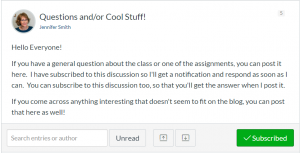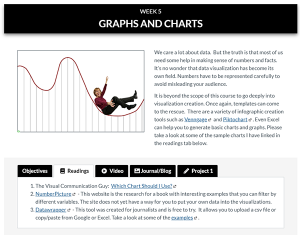Online Teaching and Learning
29 Humanize Your Online Course
Jennifer Smith
One of the things that instructors tend to dislike most about online teaching is the perceived lack of connection between teachers and their students. While it is true that connecting with your students online requires more effort and may be different than what you find in a face-to-face classroom, you can still foster meaningful, high-quality relationships.
Students who feel connected to their instructors are more likely to log into the course and do the hard work of learning. Regardless of modality, students who feel that their instructor genuinely cares about them are likely to be more forgiving when issues arise. For more information on humanizing your course, visit the Diversity, Equity and Inclusion chapter.
Without the personal touch of the course instructor, a Canvas course site feels like a cold and unwelcoming place. Images and videos can help you to give the online environment “personality.”
Canvas Profile

- Upload a photo to your Canvas profile
- Click the “Account” button at the top left
- Choose “Profile” from the list
- Click on the circle with the generic icon at the upper left next to your name
- A pencil should appear and you can upload a picture or take a photo there
- Your photo should communicate to students, “I care about you and I’m here to help!” so smile!
- Add a bio to your Canvas profile
- Tell students what you love about the course and about teaching
- Share a personal interest or hobby
Other Images

Add appropriate and meaningful images to your Canvas course site to make your course visually appealing and friendly. Photos of you working in the field are terrific! But if you don’t have those, images that relate to the topic being discussed will work fine. Of course, it is important to properly credit images that are not your own.
Video Recordings
Most of us dislike audio and video recordings of ourselves. But video can be a great way to connect with your students. The trick is to keep it simple and picture the students with whom you are talking. Your pre-recorded videos don’t need to be long, but they can save you time during your synchronous class meetings as well as help your students feel that you care and are there to support them.
Use the video or audio recording feature within Canvas Speedgrader to provide feedback. Text can sound impersonal and cold. Through a recording, students can hear the tone of your voice. Depending upon how fast you type, recording feedback could be a time-saver!
Creating Connections with Students Online
The workshop linked below discusses proven ways of creating meaningful interaction with the remote instructor. A few examples: include clever introductions of yourself, humanize your course, provide weekly overviews, personalize content, utilize cooperative learning, enable real-time communication, incentivize learning with rewards, and emphasize a bottom line.
Tiff Jenson: Creating Connections with Students Online (1:20:45)
References
Dickinson, A. (2017). Communicating with the Online Student: The Impact of E-Mail Tone on Student Performance and Teacher Evaluations. Journal of Educators Online, 14(2). doi:10.9743/jeo.2017.14.2.5
Ley, K., & Gannon-Cook, R. (2014). Learner-valued interactions: research into practice. Quarterly Review Of Distance Education, (1), 23.
Luo, N., Zhang, M., & Qi, D. (2017). Effects of different interactions on students’ sense of community in e-learning environment. Computers & Education, 115153-160. doi:10.1016/j.compedu.2017.08.006
Orcutt, J. M., & Dringus, L. P. (2017). Beyond Being There: Practices that Establish Presence, Engage Students and Influence Intellectual Curiosity in a Structured Online Learning Environment. Online Learning, 15 – 35.
Richardson, J. C., Koehler, A. A., Besser, E. D., Caskurlu, S., JiEun, L., & Mueller, C. M. (2015). Conceptualizing and Investigating Instructor Presence in Online Learning Environments. International Review Of Research In Open & Distance Learning, 16(3), 256-297.

